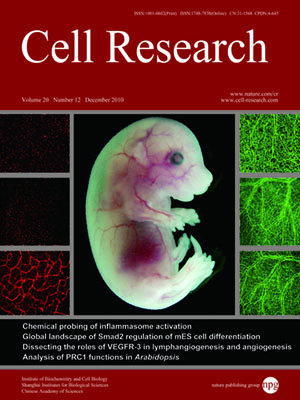
Volume 20, No 12, Dec 2010
ISSN: 1001-0602
EISSN: 1748-7838 2018
impact factor 17.848*
(Clarivate Analytics, 2019)
Volume 20 Issue 12, December 2010: 1345-1360
ORIGINAL ARTICLES
A switch from hBrm to Brg1 at IFNγ-activated sequences mediates the activation of human genes
Yi Zhang1,2,*, Mo-bin Cheng1,*, Yan-jun Zhang1, Xin Zhong1, Hui Dai1, Li Yan1, Ning-hua Wu1, Ye Zhang1 and Yu-fei Shen1
1National Laboratory of Medical Molecular Biology, Department of Biochemistry and Molecular Biology, Institute of Basic Medical Sciences, Chinese Academy of Medical Sciences & Peking Union Medical College, 5 Dongdan Santiao, Beijing 100005, China
2Current address: Yale University School of Medicine, Section of Pulmonary and Critical Care Medicine, New Haven, CT 06520, USA
Correspondence: Yu-fei Shen, Ye Zhang,(yfshen@imicams.ac.cn, yfscams@gmail.com; yezhang@pumc.edu.cn)
The SWI/SNF chromatin-remodeling complexes utilize energy from ATP hydrolysis to reposition nucleosomes and regulate the expression of human genes. Here, we studied the roles of human Brahma (hBrm) and Brahma-related gene 1 (Brg1), the ATPase subunits of the SWI/SNF complexes, in regulating human genes. Our results indicate that both hBrm and Brg1 interact with Signal transducer and activator of transcription (Stat) 1 in vitro. However, Stat1 in its native form only recruits hBrm to IFNγ-activated sequences (GAS) of individual genes; by contrast, in a stress-induced phosphorylated form, Stat1 mainly binds to Brg1. Under basal conditions, hBrm is recruited by native Stat1 to the GAS and exists in a mSin3/HDAC co-repressor complex on the hsp90α gene, which shows a compact chromatin structure. Upon heat-shock, hBrm is acetylated by p300 and dissociates from the co-repressor complex, which the phosphorylated Stat1 is increased, and binds and recruits Brg1 to the GAS, leading to elevated induction of the gene. This hBrm/Brg1 switch also occurs at the GAS of all of the three examined immune genes in heat-shocked cells; however, this switch only occurs in specific cell types upon exposure to IFNγ. Regardless of the stimulus, the hBrm/Brg1 switch at the GAS elicits an increase in gene activity. Our data are consistent with the hypothesis that the hBrm/Brg1 switch is an indicator of the responsiveness of a gene to heat-shock or IFNγ stimulation and may represent an “on-off switch” of gene expression in vivo.
Cell Research (2010) 20:1345-1360. doi:10.1038/cr.2010.155; published online 16 November 2010
FULL TEXT | PDF
Browse 2386


